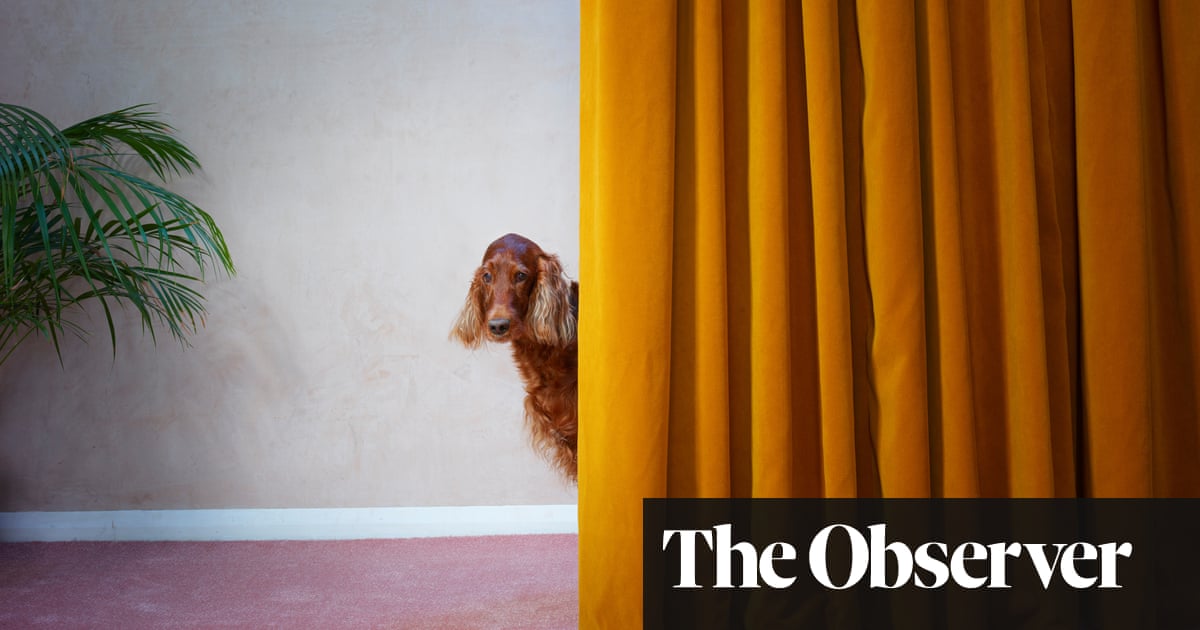When children get scared, we can explain that there are no sharks under the bed. Dogs, when they’re fearful, are harder to reason with. You may not realise how distressing this can be – and I don’t only mean for the dog.
My own miniature schnauzer, Peanut, became fearful this year. Her case may not be as bad as many others, but she’s my dog and I want to help her. So I called the animal behavioural scientist Dr Zazie Todd, author of Bark! The Science of Helping Your Anxious, Fearful, or Reactive Dog.
Originally from Leeds, Todd now lives outside Vancouver, British Columbia, with her husband, cats and an elderly dog called Pepper. From her desk overlooking the woods, she helps dog owners all over the world through her blog, Companion Animal Psychology, her podcast and one-to-one sessions over Zoom. Typically, in these sessions, clients show her a video of problematic dog behaviour and she watches as they attempt to remedy it.
As you might expect from a scientist, Bark! is encyclopaedic in scope and packed with references to new findings about animal behaviour. Dogs have always been susceptible to fears: of other dogs, separation anxiety, trips to the vet. But, says Todd, dogs today are living in an “epidemic of fear” that started in the pandemic. Reputable breeders, who set a limit on pregnancies, couldn’t meet soaring demand and unscrupulous breeders filled the gap with puppies whose mothers were likely to have experienced stress during pregnancy. Stress hormones may have flooded the puppies in utero, Todd says, and many will have been raised in barren environments or small cages, with few opportunities to play or socialise during the crucial period from three to 14 weeks after birth.
Having found a permanent home, pandemic puppies became accustomed to their owner being home at all times and gained little exposure to normal sights and sounds – making it hard for them to cope with being home alone and to deal with ordinary life outside.
We’re still seeing the consequences. According to recent figures from Dogs Trust, approximately 40,000 dogs are abandoned or handed over to local authorities in England and Wales each year. Behavioural issues are a common cause, but not just in “pandemic dogs”. Many cases of aggression in dogs arise from fear or anxiety. Other dogs are reactive or emotionally unregulated. They react negatively or disproportionately to what is commonplace to them – they might cower, bark or growl at a stranger encountered on a walk, for instance, or in their excitement at meeting a new dog will lunge and bark. “Whatever the challenges you face,” Todd writes, “the day-to-day difficulties of caring for a fearful dog can be stressful, and may involve making big changes”. Telltale signs of anxiety in dogs include low body posture, stiff movements, ears pinned back, a tucked tail and seeking out familiar people.
Katya Robin took in a Romanian rescue dog after her previous dog died. Mika was frightened of other dogs and a previous attempt to rehome her failed as she was introduced to other dogs too quickly, leading to fights. To avoid direct confrontations, Robin took Mika for walks in a cemetery, near her Sheffield home, where she could see other dogs before Mika did and dodge confrontations by strategically obscuring her view behind headstones.
But it wasn’t easy. Mika was frightened of thresholds, such as doorways, and the intersecting paths in the cemetery. Instead of walking in straight lines, Mika would weave. “And she would cut the corner, dragging me and my mobility scooter in her wake.”
Like Robin, the broadcaster Rory Cellan-Jones took in a Romanian rescue dog, found abandoned on a roadside with other puppies. He shared her arrival in his home on social media – gaining 100,000 followers in six months – and now in a book, Sophie From Romania. For a long period, Sophie was too terrified to come out from behind the sofa. “As for walks, well, they proved impossible,” he wrote. “I quickly realised I’d bitten off more than I could chew.”
With dogs like Mika and Sophie, it may be impossible to understand what first caused the fear or anxiety. (There’s a difference: fear is specific, anxiety is general.) Some cases may seem trivial. Todd’s shih tzu, Pepper, was scared by a coffee-maker grinding beans noisily on a timer. Another owner told me his schnauzer, as a puppy, witnessed a van coming up on to the pavement to bypass traffic and grew up afraid of moving wheels, barking furiously. That is stressful for the owner and anyone else nearby.
Fear is easy to acquire, says Todd, and hard to lose. The impossible ideal is to avoid it altogether by ensuring that young dogs have good first experiences of as many sights and sounds as possible. That was certainly the case for Peanut, who came to live with my family in London at the age of five, having retired after producing three litters. She came from a reputable breeder who also trained police dogs. Far from fearful, nothing seemed to faze her. But this year, soon after Peanut’s 10th birthday, that changed.
I used to take her with me to bookshops. While I browsed the shelves, she would lie in a streamlined position, like a silver bullet, nose pointing to the exit. I admired this subtle hint, but ignored it. One day two young men came into the bookshop, talking loudly and laughing. Peanut leaped up, tucked her tail between her legs and scuttled behind me. She’s still wary of the bookshop and pulls away from it whenever we pass by. She seems to associate the bookshop with sounds that now frighten her.
Soon after, we took her with us to a family restaurant with. A group at a nearby table kept breaking into laughter, causing Peanut to scuttle under my legs once again. At another table, a man clapped sharply, as if to commemorate a winning argument. Peanut panicked, circling between us, lifting both feet on to a lap and panting, raising her nose to the sky to beckon us home. Now, if we walk near that restaurant, Peanut pulls sharply away on her lead towards the kerb. Then came November, with its endless impromptu fireworks. Peanut had never previously been worried by them, but this year, a single loud bang made her tuck her tail under and scuttle towards us. She had become a fearful dog.
Dogs learn by association. If X happens, then Y follows. So old-fashioned “tough” training methods can’t reduce canine anxiety, Todd insists. They make it worse.
Take the dog that barks at moving wheels. The barking could easily be regarded as “bad” behaviour, for which an old-fashioned trainer might punish the dog. Todd’s book includes a horrifying list of not-uncommon aversive training methods, of which the mildest include yelling at a dog or hitting it with a newspaper. But if you hit a dog because it barks at moving wheels, you’ll make the dog fear moving wheels even more, because the appearance of them seems always to be followed by a whacking.
Set aside aversive methods, Todd urges. Instead, work with a dog’s natural tendency to learn by association.
Ever since Ivan Pavlov noticed that dogs associated a particular sound with the arrival of food, behavioural scientists have assembled a vast amount of evidence and insight into how dogs (and other mammals, including humans) learn by association. “The aim of counter-conditioning is to teach the dog to love the thing they were previously scared of,” Todd says. At its most basic, that can mean shovelling delicious snacks into your dog to help it overcome the appearance of a moving wheel.
Todd did something like this to help her own dog, Pepper, overcome his fear of the coffee grinder. “Treats helped enormously. Within days, Pepper was no longer running around terrified. Now, when he hears the noise, he looks expectantly for his treat.” Todd’s instructions are simple: “Pick a treat that your dog really loves. If something scary starts to happen, give them that treat.”
For this to work, the pleasant surprise must be really wonderful, not just any old treat. Todd recommends cooked chicken, roast beef, meatballs, parmesan, cheddar, cat food, tuna, sardines, scrambled egg and any commercial treats your dog loves.
And you need to get the timing right, because if you give the treat first and then the scary thing happens, your dog may start to associate the treats with something threatening. “Make sure they have seen the scary thing before you reach for the treats,” says Todd. You must also be ready to supply them every time the scary thing happens. Slightly alarmingly, Todd suggests that I might carry pre-sliced offal sticks with me everywhere, in what Americans call a fanny pack.
Counter-conditioning involves desensitising a dog to whatever frightens them by breaking it into component parts and reducing the fear one step at a time. Todd worked with a similar case to Cellan-Jones’s Sophie. The dog in question had so much anxiety that Todd thought it best to remain unseen and began the training by chucking treats through a door. Only gradually did she allow the dog to see her, but avoided eye contact. Then she joined it in the same room, sitting on the floor, still with no eye contact. Eventually, the dog was willing to put on a harness and go for a walk outside.
People are understandably impatient, Todd says. The early stages can seem to go on forever. But after the slow start, she says, improvements can come rapidly. And the sense of achievement, at the end, is huge. “Time is on your side.”
More than once, Todd asked me if Peanut was in pain. I brushed off the idea, but then remembered that she was in pain last year – a lot of pain – right in the middle of fireworks season. She had several teeth removed, which ended the pain. When a dog’s in pain, Todd says, its tolerance threshold is reduced and Peanut may have become sensitive to loud noises then.
Other dog owners deal with much worse, including Cellan-Jones, who admits to asking himself if “getting a dog from Romania was a little rash”. There have been moments of joy when she makes a breakthrough, such as Mika snuggling up in her bed for the first time, but also moments of frustration, even despair “when she retreats back into her shell and refuses to engage with any of us”.
Robin put the hours in with Mika, the Romanian rescue dog, holding regular sessions with a dog-trainer, over a long period. Time, patience, love – and a lot of treats – enabled Mika gradually to become more comfortable and secure. “She learned she didn’t need to eat snails she’d found for survival and she discovered the joy of playing with toys,” says Robin. “She sat on the sofa beside me, and became a loving and devoted companion.”
Bark! The Science of Helping Your Anxious, Fearful or Reactive Dog by Dr Zazie Todd is published by Greystone Books at £19.99. Buy it from guardianbookshop.com












